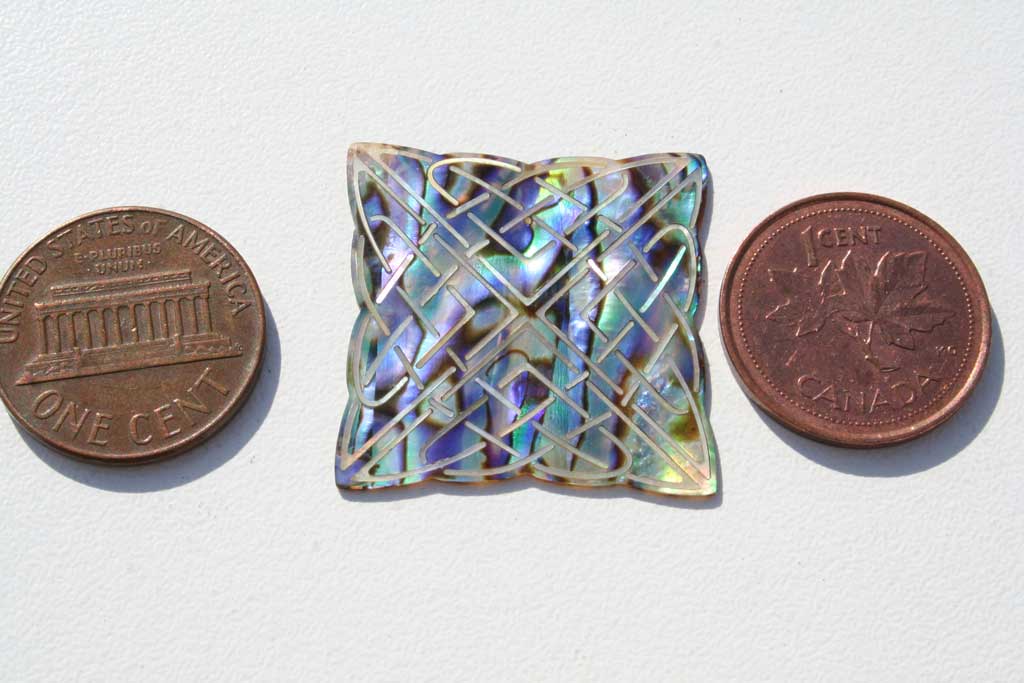
With some encouragement from The Duke himself, I decided to try and push the limits a bit with my inlay work. In the interest of fairness, I included pennies from both sides of the border.
| Official Luthiers Forum! http://w-ww.luthiersforum.com/forum/ |
|
| Newest inlay work, most detailed yet http://w-ww.luthiersforum.com/forum/viewtopic.php?f=10102&t=14072 |
Page 1 of 1 |
| Author: | Bob Garrish [ Mon Oct 15, 2007 3:30 am ] |
| Post subject: | |

With some encouragement from The Duke himself, I decided to try and push the limits a bit with my inlay work. In the interest of fairness, I included pennies from both sides of the border. |
|
| Author: | Bob Garrish [ Mon Oct 15, 2007 3:35 am ] |
| Post subject: | |
The knot is abalone inlaid with gold MOP. The gold MOP strips are just under 0.014" thick. It's really, really shiny so it was quite a hassle to get a picture where you could see all the details clearly. The photo's unedited, but the image compression took out a chunk of the colour from the abalone. That's about as close as I could get it to focus with the kit lens on my camera. |
|
| Author: | Sam Price [ Mon Oct 15, 2007 3:48 am ] |
| Post subject: | |
My gosh...what DELICATE WORK!! I can see the gleam of the gold pearl in the top left of the peice. Is this for the headstock? |
|
| Author: | Michael Dale Payne [ Mon Oct 15, 2007 3:49 am ] |
| Post subject: | |
 
|
|
| Author: | Dennis Leahy [ Mon Oct 15, 2007 4:16 am ] |
| Post subject: | |
You know, I can visualize how you might be able to hold down a penny-sized piece of shell with a vacuum and cut the micro channels. But, how in the world did you hold the shell to cut the gold MOP inlays??? The only way I can think of is that this piece is two layers: the gold MOP layer below is cut in relief so the "inlays" stick up proud of the surface, and the abalone is cut with channels that slide over the MOP. But you said "The gold MOP strips are just under 0.014" thick", so I must be wrong. However you did it, it is amazing. Beautiful work - warms my Irish American heart! Dennis |
|
| Author: | Bob Garrish [ Mon Oct 15, 2007 5:31 am ] |
| Post subject: | |
I guess I should say 'wide'? The gold pearl and the abalone are both full-thickness (0.05"). The pearl is inlaid into the abalone in individual, tiny pieces. |
|
| Author: | WaddyThomson [ Mon Oct 15, 2007 8:59 am ] |
| Post subject: | |
Incredible!   
|
|
| Author: | TonyKarol [ Mon Oct 15, 2007 9:02 am ] |
| Post subject: | |
I guess it was probably glued to a backer board with titebond or the like, then soaked in water to release it once cut Dennis. When making duplicate or mirrored pieces, I use titebond to glue two blank pieces together, cut and shape, then soak them - works great. |
|
| Author: | BOBP [ Mon Oct 15, 2007 10:05 am ] |
| Post subject: | |
Bob, not to hijack this thread but I heard you make acrylic sanding dishes is it so?   
|
|
| Author: | Bob Garrish [ Mon Oct 15, 2007 11:53 am ] |
| Post subject: | |
Tony's right that it's all glued to a backer board for the cutting, I forgot to mention that one. Guys use hide glue or CA. As for the acrylic dishes, they're on the list of things I used to make but couldn't seem to sell. Those, along with billet aluminum sanding blocks and cheap vacuum bridge clamps. I do have a few pieces of acrylic big enough sitting around, though, if you're interested. The dishes were designed to be used with a vacuum 'lid' so you could clamp braces in them, though the acrylic has other benefits (water and glue proof, doesn't warp, really hard). |
|
| Author: | Dave Anderson [ Mon Oct 15, 2007 1:05 pm ] |
| Post subject: | |
Truly incredible inlay work Bob !   
|
|
| Author: | RobE [ Mon Oct 15, 2007 1:16 pm ] |
| Post subject: | |
That is amazing.  
|
|
| Author: | KenH [ Mon Oct 15, 2007 4:08 pm ] |
| Post subject: | |
Bob, your work is top drawer!! This piece is simply incredible!
|
|
| Page 1 of 1 | All times are UTC - 5 hours |
| Powered by phpBB® Forum Software © phpBB Group http://www.phpbb.com/ |
|